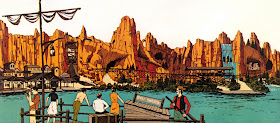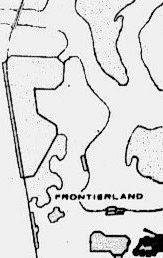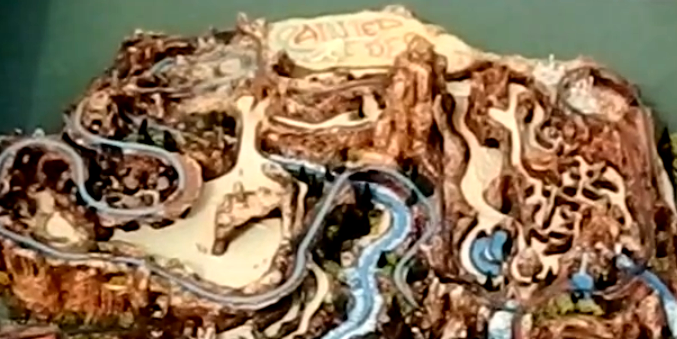Note to researchers: this post has basically 90% accurate information but does not present the full version of this attraction's story - please tread carefully until such a time as I can update this series!
Let's look at what was going on inside that thing.
Okay, now, before anyone panics don't worry, I was fooled at first too. What you're looking at is three show buildings - working from left to right I call them A, B and C - which contain the Western River Expedition boat ride. The open space in the center is where the pond, final drop, and boarding area of the canoe ride is located.
To make this easier to look at, and think about several years ago I tried to convert this 3/4 view model into a 2D layout. I made some guesses and took some liberties; this is merely a look at what it could've been like, corroborated by tiny, grainy photos of a model.
To begin with, on this blueprint the train track goes straight through the building but appears to slightly curve in all of the models I've been able to find. Secondly, there's a whole section of building on the other side of the train track not accounted for on that blueprint:
You can see it in that interior model, the Walt Disney World Railroad bisecting the two parts of the building.
To me that looks like a ride-through diorama. Not a Grand Canyon-style one; this seems to be based on the seasons. We can see open fields, lightning strikes, a forest and waterfall or stream, and a snow covered landscape.
Mike Cozart informs me (in the comments for this very blog post - thanks Mike!) that this diorama had a number of Davis gags designed for it and which are sometimes misrepresented online as Nature's Wonderland gags - the forest was likely intended to be full of comic bears in the Nature's Wonderland style.
It's also possible this is where the long-gestating idea, championed by Dick Nunis, of the Railroad going through a snowstorm originated. Regardless, it's the sort of thing the east coast railroad has always needed and never has had.
Okay, enough preliminaries. Let's go inside and ride Western River Expedition!
IV. WESTERN RIVER EXPEDITION
Western River Expedition was to be housed in two enormous show buildings with a third, merely large show building connecting them. Each of these show buildings were comparable in size to the Pirates of the Caribbean main show room and likely would have felt very similar, only with rock work instead of a Caribbean town: open ceilings, walls covered in cloud projections and perspective effects, a whole little world with a roof on it.
After entering below the giant ore elevator, guests would walk through a mine shaft and exit into Show Building A, which represents a canyon at sunset.
Casting off from a simple wooden loading dock, the boats drift placidly though a canyon as the sounds of nature overtake the boat.
What happens next depends on interpretation of available materials. We know for sure that the boats approach a cave. If you think Hoot Gibson appears in the ride it's likely at this spot, starting to narrate the scene and setting. Alternately, as we approach the cave we notice nestled in among the rocks are gigantic Western dime novels of adventure and cunning. This strikes me as a weirdly cartoonish concept to introduce at this point in the ride, but we have a beautiful Davis rendering of it and none others from this early part of the ride.
A close look at the model shows splotches of red, yellow and blue on the rocks to the left before the cave, suggesting a kind of indoor variation on the Devil's Paint Pots from Nature's Wonderland. You can look at the evidence and make up your own mind.
The boats pass into a darkened cavern filled with hundreds of stalactites.
A stalactite comes into view shaped like a rabbit. From inside this stalactite, echoing dimly in the cavern, a bit of music plays, imagine perhaps rhythmic drums.
The boats pass more stalactites that resemble increasingly familiar Old West shapes - a coyote, a cowboy, an old man. From inside each stalactite, a bit more of the melody emerges until the entire cavern feels filled with ethereal music and we notice ever more familiar shapes in the flowing rock work.
Exiting the cavern, the boats slip gently through a desert at dusk as they are followed by the Western River Expedition theme music summoned in the caverns. Slightly above the boats off to the left, a railroad track runs - and occasionally a full size train rumbles past, the Walt Disney World Railroad passing through.
Back outside in the simulated night air, the music has taken on a minor key. A chorus of singing voices may be heard, until the boats turn a corner and reveal a stagecoach holdup taking place on a bridge spanning the Western River:
The Bandits holding up the Stagecoach, complete with their own personal mariachi and theme song, seem too busy with their latest crime to stop and rob us too - but, the leader in a top hat menacingly suggests to us, all in song, that he may meet us again soon.
Amongst those who have researched Western River Expedition, my placement of the stagecoach holdup sequence is unusually early. Yet if what I'm seeing on the model is correct, this is where the scene was supposed to go, and to me the proof is the rendering above. The view above shows the scene as it would have appeared to the Walt Disney World Railroad, and we can clearly see from the model that the Railroad peeked into the ride at this point. Certainly the Railroad is what motivated the placement of the Stagecoach itself high up that bridge. This is why I choose this version of the scene, as opposed to the many variants Davis drew.
Passing underneath the Stagecoach, boats wind their way through the open prairie at nightfall. White clouds gently rake a periwinkle blue sky. All around, large shadowy buttes dot a landscape and open sky awash in twilight blue.
A group of Buffalo curiously investigate the home of some prairie dogs.
Nearby, a cowboy sings to calm his cattle under the night sky. His tune is a slow-step version of the Western River Expedition theme. The cattle join in, bellowing along with his tune.
Framed in natural rock arches, coyotes howls pick up the tune. The underscore music swells.
The cowboy's team rest nearby around a campfire, bringing another guitar and harmonica into the mix. Picking up the tune is the cook at the chuck wagon...
...and an entire chorus of cactus!
The placid strumming of the cowboy song transforms into a honky tonk piano. Raucous shouting may be heard, and gunfire.
Now, here comes the part where some interpretation is needed. The "Town of Dry Gulch" sequence coming up next is the sequence of the ride that Davis did an extraordinary volume of work for; it's also the one which he drew a lot of gags that did not end up in the final version of the show. Davisophiles have been circulating this work online for years, because it's brilliant stuff, but this has also given a bloated picture of how long this sequence was intended to be.
Davis also revised the scene at least once, in the process extending it out around the corner into the next scene. As far as I can tell in the 1971 version of the ride, the only one Disney got anywhere near actually building, the town was a simple two-sided affair, with clapboard buildings in both sides of the ride flume and the bridge over the river at the end:
So that's the shape of the town I'm going to be working with here. Also, to fully understand this scene we have to (finally) bring in discussion of Mary Blair's work on the ride.
It's well known that Marc wanted to use Mary Blair's art to color-style the ride. Unlike with It's A Small World, however, the ride wasn't necessarily going to end up looking like a piece of Mary Blair art. The fact that Davis would from time to time put out pieces of Western River art with similar Mary Blair bold colors has led to yet more confusion.
Western River Expedition was intended mostly to be made up of rock work and desert scenery, and it was going to be WED-style stylized naturalistic rocks and scenery, with Blair vivid colors. The "Night on the Town" sequence in Western River Expedition would be the height of the ride's intense color stylization.
The right side of the town set would be bathed in bright blue moonlight, the houses standing out against the hue with green clapboard and yellow windows.
This blue-toned side of the town would be filled entirely with Cowboys drinking and carousing, shouting and singing.
Surrounded by torches, a Snake Oil salesman at the end of the street demonstrates his wares with the help of a native chief, with music provided by a nearby brave and squaw on banjo and trombone.
The left side of the street is bathed in a fiery red by the setting sun. On this side, a bank robbery and gun battle is underway.
Robbers have pulled the entire safe out of the bank and are using it as a shield.
The sheriff hangs out of the Tonsorial Parlor, returning fire. (This gag is lifted almost directly from For A Few Dollars More, and I must admit I did not expect Davis to be a potential Sergio Leone fan)
His Calamity Jane-style deputy hides behind a building, taking an absurdly long time to choose her targets.
And, at the end of the street:
The Blue/Red split that mirrors the tone of the scenes found on either side of the river is the boldest stylization found on the ride, and even more remarkable for being conceived in the form of a sunset. I've done a watercolor interpretation of what this could have looked like in person. Because this will no doubt be misconstrued by somebody as authentic concept art, I've put a big, dumb watermark over it to hopefully prevent more misinformation being circulated about this ride.
Boats turn a corner towards the left and pass through a narrow canyon between two buttes. The sounds of the honk-tonk piano and gunfire fade as now pounding native drums take up the rhythm of the Western River Expedition theme.
The transition out of the Dry Gulch scene and into the next is made by passing under a bridge:
 |
| thanks to Jaime Maas |
We come across a group of plains Indians. They sway back and forth mysteriously to the pounding of their drums as a Shaman dances crazily, only slightly distracted by the shapely lass to his left. Far up above atop a butte, a rain dance is performed, and it's remarkably effective, sending cascading rain down... atop only the butte, at first. Water pours down the side of the butte, widening into flowing rivers and rushing towards the boats.
Storm clouds glower overhead and bolts of lightning tear the sky as rain can be seen falling on the distant plain. The little boats move slowly towards a dark canyon straight ahead.
Thunder and lightning rip the sky far above as we slip slowly into the narrow space. Flood water begins to pour into the canyon from the buttes above to the left and right, spattering on jagged rocks.
Arriving at the top of the waterfall, the boats move slowly through a great forest at the top of the butte on the edges of the plain. The rain continues to fall, but the rain dance was too late - the lightning has already set the trees ablaze.
The tall trees have already begun to topple and the boats pass below several as they creak and groan, flames dancing atop each one when into view comes:
The bandits stop the boat and demand your money. After a moment's hesitation, the boats slip down a waterfall to escape, splashing down in a darkened cave.
The canyon at sunset where we began comes back into view, and with it returns the triumphant, Hollywood version of the Western River Expedition theme. Boats return to the little wooden dock where they boarded and passengers disembark, back through a mine shaft, emerging at the base of the huge Thunder Mesa complex.
V. THE 1974 VERSION AND MUTATIONS
The Fall 1973 Oil Crisis killed off a lot of stuff at Walt Disney World that it shouldn't. Disney should have kept building hotels, but the Asian and Persian got axed. They should have built more rides, but following 1973 anything that wasn't a roller coaster had no hope of getting off the ground. Everything that wasn't being actively constructed as of Fall '73 got put on indefinite hold, and once the race towards EPCOT Center's starting pistol was fired in early '77, many projects were abandoned. Western River Expedition was one of them.
But it wasn't really until 1976 that the curtain was pulled over Western River Expedition for good. In that year, Walt Disney Productions changed their age of retirement, and perhaps sooner than he expected, Marc Davis was out. He did return for a time in 1977 to plan additional attractions, including designing nearly all of the sight gags for World of Motion, but when Marc left, Western Rive Expedition was without a mastermind and it faded quickly.
Now, most histories, including Disney's official history published in "The Disney Mountains: Imagineering at its Peak" strongly imply (or outright state) that the attraction's less-than-austere treatment of Native Americans is what killed it off, a suggestion I've done some work in this series to debunk. However, the fact remains that in the mid-70s, Marc did see fit to make a few changes. He removed nearly all of the Indians from his ride.
The first group to go were the three in the Medicine Show; Marc replaced the Chief with a generic Strong Man and lost the comedy of two Indians playing banjo and trombone:
The Medicine show gag was neither here nor there on the offense scale, but it was carefully placed to foreshadow the Rain Dance sequence, which was perhaps a bit more problematic with the short swarthy Medicine Man gawking at a tall, buxom Squaw. So Davis dropped the entire Rain Dance scene.
We do know he kept the lone Indian irritated on the bridge with the guns-blazing cowpoke, and it's because we can see it in the next piece, which shows an expanded version of the "Bank Robbery" tableau. This version would extend around the corner past the original Dry Gulch scene, and fill both sides of the river. I flipped it earlier in this article to give some notion of the original '71 Robbery scene, of which I have no good, wide view of.
Across the way, more sheriffs and townsfolk continue the shootout. "Calamity Jane" has been relocated here. This is where the oft-repeated tidbit of a gunfight on either side of the boats comes from, an idea repeated in Phantom Manor's "Ghost Town" sequence.
Notice the punctured water wagon at the end, obviously intended as a visual transition into the rainstorm / flood sequence to follow.
And, as far as changes made to purge the ride of politically incorrect content goes, that was it. The ride simply always was more "Cowboys" than "Indians". Once I finally got a better idea of the actual flow of the ride, I realized that not only this issue, but the entire Dry Gulch sequence has been greatly inflated in importance from years and years of retelling. The bulk of the ride would have been the same sort of stuff that the bulk of Pirates of the Caribbean in California is: rocks, special effects projections, music, and evocative atmosphere.
Amazingly enough, after being killed for good on the East Coast, Western River Expedition popped back up on a proposed 1978 expansion for Disneyland, the "Land of Legends", intended to connect Bear Country to Tony Baxter's Discovery Bay.
There's a tempting land if ever I've seen one... the idea of Western River sitting alongside dark rides for Ichabod Crane and Windwagon Smith is a daunting one. Much like Discovery Bay and Dumbo's Circus, ballooning costs on EPCOT Center killed off this obscure but delightful idea.
And then there's the rarely discussed plans for a small Old West-themed theme park at Walt Disney World, sometimes called Frontier Kingdom, located southwest of the Seven Seas Lagoon. practically no information about this exists, but Western River Expedition is usually cited as one of the major rides. However, as we know, it was all for naught and nobody has yet been able to get Western River into production since 1971.
Come back next week for a final discussion of Western River Expedition and Marc Davis' intentions with this ride.
Western River Expedition Series: Part One | Part Two | Part Three
Do you enjoy long, carefully written essays on the ideas behind theme parks, like this one? Hop on over to the Passport to Dreams Theme Park Theory Hub Page for even more!





























































